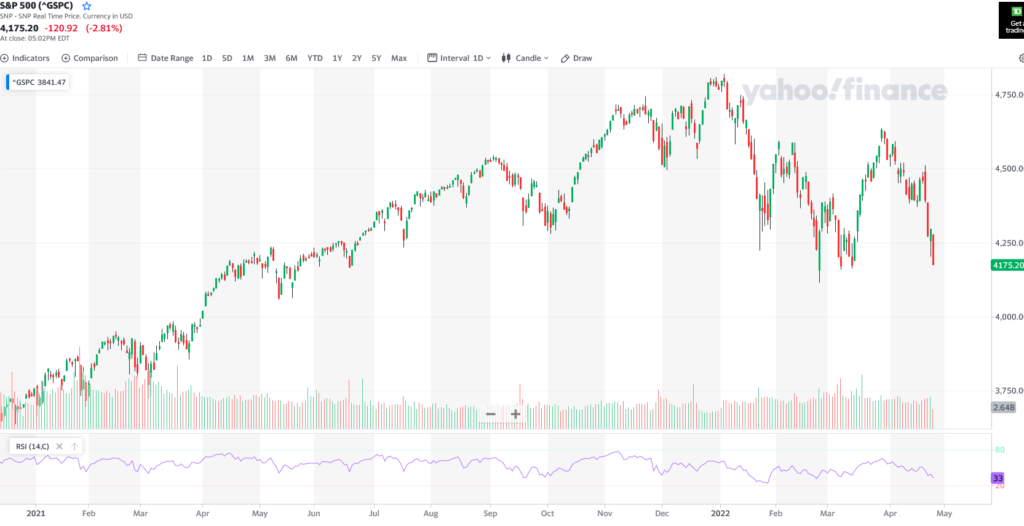Stocks fell sharply today adding to losses over the past few weeks. The S&P 500 dropped 2.8%. Tech and small caps were hit the hardest, with the Nasdaq falling almost 4% and the Russell 2000 down 3.26%. The Nasdaq closed at its lowest point since December 2020, erasing over a year of gains. So far, this has not been a great year for stocks. The S&P 500 is down 12.4% year-to-date and the Nasdaq is down 20.16%.
Bonds have not fared well either and provided little help to diversified investors. AGG, the iShares Aggregate Bond ETF, is down 8.5% year-to-date. Because of this, many investors are really feeling the pain this time around unlike during the pandemic sell-off in 2020 where rates fell and bonds rallied to provide a cushion to losses in stocks. The ubiquitous 60/40 benchmark (60% S&P 500, 40% intermediate treasury bonds) is down 10.8% year-to-date.
What has worked in this environment?
Thanks to rising inflation, commodities and energy stocks have actually fared pretty well this year. Our tactical investment strategies have benefited from exposure to both. XLE, the Energy Select Sector SPDR Fund, is up more than 34% this year. DBC, the Invesco DB Commodity Index Tracking Fund, is up more than 31% this year.
Why is this happening?
Several risk factors are converging on markets right now in an unprecedented way. We came into the year facing rising inflation. Inflation in and of itself is not bad for markets. However, the Fed’s actions to combat inflation can be harmful to markets. The Fed fights inflation by raising interest rates and reducing its balance sheet (aka reducing the money supply).
Rising rates means falling bond values and pressure on highly leveraged (heavily indebted) companies like technology or growth stocks. And the inflationary problem has only been exacerbated by Russia’s war in Ukraine, the ensuing sanctions, and new lockdowns in China in response to a new wave of COVID-19. There is increasing concern that the U.S. may be slipping into recession due to these various risk factors.
What happens next?
As long as these conditions remain and the Fed remains committed to raising rates, volatility will likely continue. Bear markets are part of the natural cycle of markets. The Nasdaq is already in a bear market according to the technical definition (a drop of at least 20% from a recent high). At the end of 2021, few would have guessed that we would now be facing a bear market, but this proves how quickly these things can occur and how hard they are to predict.
Thankfully, for us, our tactical investment strategies came into the year quite defensively and heavy on cash. Our Leveraged MASTER strategy started the year positioned in URPIX—the ProFunds UltraBear Investor Class, which has provided handsome returns. This fund delivers two times the inverse of the daily return of the S&P 500. This has provided a great hedge in this volatile environment.
As believers in the concept of momentum, we must recognize that this market could continue to go lower. Trends tend to persist. Momentum is certainly in the negative direction. All the major indices—the S&P 500, Dow, Nasdaq and Russell 2000—are negative on a 12-month basis at this point.
What’s the bright side?
There is, of course, a lot to potentially be positive about. The S&P 500 came close to a new low but was not able to reach it today. Also, stocks have bounced in this general area before so there is hope that at these levels there may perhaps be some buyers to instigate a rally. Additionally, stocks are very oversold at the moment, although they do have room lower, and these are typically conditions under which a bounce emerges. The RSI on the S&P 500 is currently 33.

Geopolitical developments could be catalysts for a move higher–a resolution to the Ukraine conflict or a reopening in China. But more importantly, as markets drop the probability rises that the Fed will flip flop by stopping their rate hiking cycle or even cutting rates. Furthermore, falling stocks will likely dampen consumer spending and consumer confidence, which could provide the Fed with cover for such a change in policy.
What should you do now?
It is important in these types of environments not to make sudden, drastic changes to your overall strategy. Realize that the biggest up days often do occur near or next to the biggest down days. A knee jerk reaction could lead to missing out on a big upswing. Your strategy should be designed with these types of events in mind and if so, then you should stick to your strategy.
Related: Is A Bear Market Lurking?


